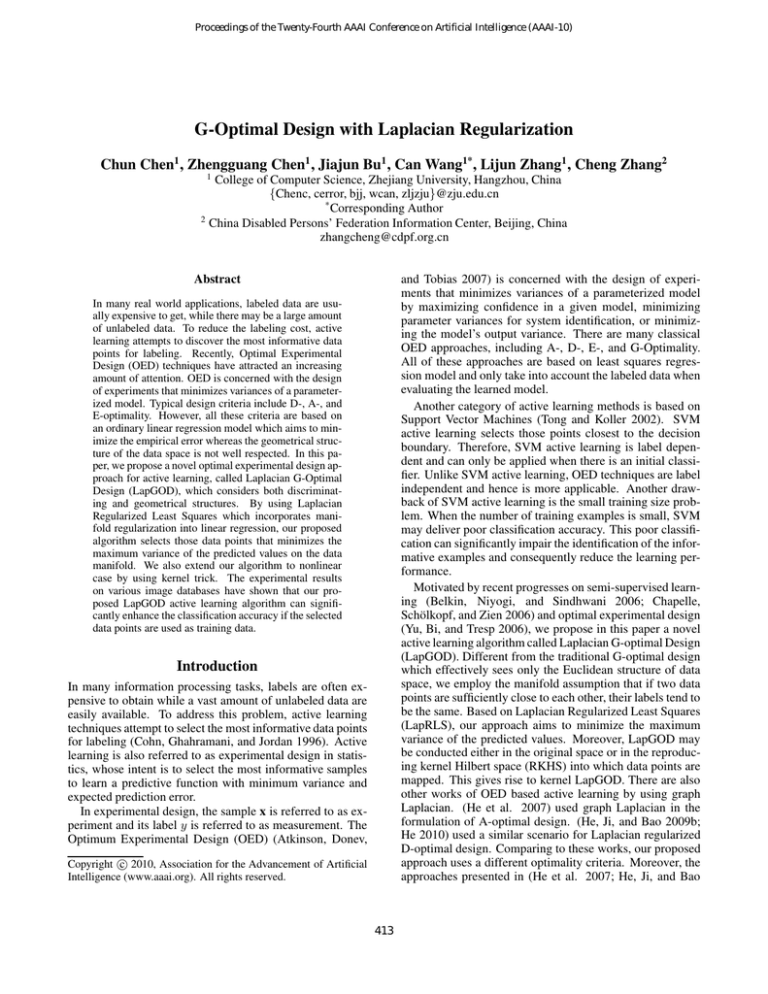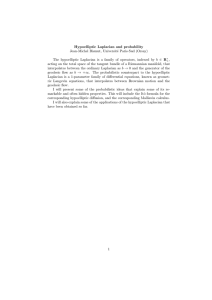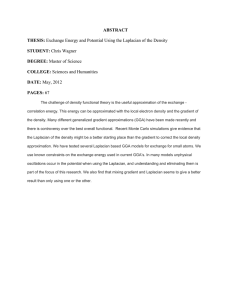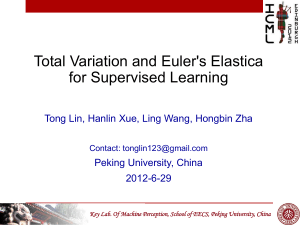
Proceedings of the Twenty-Fourth AAAI Conference on Artificial Intelligence (AAAI-10)
G-Optimal Design with Laplacian Regularization
Chun Chen1 , Zhengguang Chen1 , Jiajun Bu1 , Can Wang1*, Lijun Zhang1 , Cheng Zhang2
1
2
College of Computer Science, Zhejiang University, Hangzhou, China
{Chenc, cerror, bjj, wcan, zljzju}@zju.edu.cn
*
Corresponding Author
China Disabled Persons’ Federation Information Center, Beijing, China
zhangcheng@cdpf.org.cn
Abstract
and Tobias 2007) is concerned with the design of experiments that minimizes variances of a parameterized model
by maximizing confidence in a given model, minimizing
parameter variances for system identification, or minimizing the model’s output variance. There are many classical
OED approaches, including A-, D-, E-, and G-Optimality.
All of these approaches are based on least squares regression model and only take into account the labeled data when
evaluating the learned model.
Another category of active learning methods is based on
Support Vector Machines (Tong and Koller 2002). SVM
active learning selects those points closest to the decision
boundary. Therefore, SVM active learning is label dependent and can only be applied when there is an initial classifier. Unlike SVM active learning, OED techniques are label
independent and hence is more applicable. Another drawback of SVM active learning is the small training size problem. When the number of training examples is small, SVM
may deliver poor classification accuracy. This poor classification can significantly impair the identification of the informative examples and consequently reduce the learning performance.
Motivated by recent progresses on semi-supervised learning (Belkin, Niyogi, and Sindhwani 2006; Chapelle,
Schölkopf, and Zien 2006) and optimal experimental design
(Yu, Bi, and Tresp 2006), we propose in this paper a novel
active learning algorithm called Laplacian G-optimal Design
(LapGOD). Different from the traditional G-optimal design
which effectively sees only the Euclidean structure of data
space, we employ the manifold assumption that if two data
points are sufficiently close to each other, their labels tend to
be the same. Based on Laplacian Regularized Least Squares
(LapRLS), our approach aims to minimize the maximum
variance of the predicted values. Moreover, LapGOD may
be conducted either in the original space or in the reproducing kernel Hilbert space (RKHS) into which data points are
mapped. This gives rise to kernel LapGOD. There are also
other works of OED based active learning by using graph
Laplacian. (He et al. 2007) used graph Laplacian in the
formulation of A-optimal design. (He, Ji, and Bao 2009b;
He 2010) used a similar scenario for Laplacian regularized
D-optimal design. Comparing to these works, our proposed
approach uses a different optimality criteria. Moreover, the
approaches presented in (He et al. 2007; He, Ji, and Bao
In many real world applications, labeled data are usually expensive to get, while there may be a large amount
of unlabeled data. To reduce the labeling cost, active
learning attempts to discover the most informative data
points for labeling. Recently, Optimal Experimental
Design (OED) techniques have attracted an increasing
amount of attention. OED is concerned with the design
of experiments that minimizes variances of a parameterized model. Typical design criteria include D-, A-, and
E-optimality. However, all these criteria are based on
an ordinary linear regression model which aims to minimize the empirical error whereas the geometrical structure of the data space is not well respected. In this paper, we propose a novel optimal experimental design approach for active learning, called Laplacian G-Optimal
Design (LapGOD), which considers both discriminating and geometrical structures. By using Laplacian
Regularized Least Squares which incorporates manifold regularization into linear regression, our proposed
algorithm selects those data points that minimizes the
maximum variance of the predicted values on the data
manifold. We also extend our algorithm to nonlinear
case by using kernel trick. The experimental results
on various image databases have shown that our proposed LapGOD active learning algorithm can significantly enhance the classification accuracy if the selected
data points are used as training data.
Introduction
In many information processing tasks, labels are often expensive to obtain while a vast amount of unlabeled data are
easily available. To address this problem, active learning
techniques attempt to select the most informative data points
for labeling (Cohn, Ghahramani, and Jordan 1996). Active
learning is also referred to as experimental design in statistics, whose intent is to select the most informative samples
to learn a predictive function with minimum variance and
expected prediction error.
In experimental design, the sample x is referred to as experiment and its label y is referred to as measurement. The
Optimum Experimental Design (OED) (Atkinson, Donev,
c 2010, Association for the Advancement of Artificial
Copyright Intelligence (www.aaai.org). All rights reserved.
413
Laplacian G-optimal Design
2009b; He 2010; Zhang et al. 2009) find an approximate
solution which minimize an upper bound of the objective
function, while our approach directly minimizes the objective function.
In this section, we introduce our Laplacian G-Optimal Design algorithm for active learning. LapGOD is fundamentally based on Laplacian Regularized Least Squares
(LapRLS) (Belkin, Niyogi, and Sindhwani 2006).
Related Work
Estimated Parameter of Laplacian Regularized
Least Squares
The generic problem of active learning can be formalized as
follows. Given a set of data points X = {x1 , x2 , · · · , xm },
where each xi is a d-dimensional vector, active learning
aims to find a subset V ⊂ X containing the most informative
data points. That is, the subset V can improve the classifier
the most if it is labeled and used as training data.
Optimal Experimental Design (OED) has recently received considerable attention due to its theoretical foundation and practical effectiveness (Flaherty, Jordan, and Arkin
2005). Consider a linear regression model
Laplacian Regularized Least Squares (LapRLS) (Belkin,
Niyogi, and Sindhwani 2006) is a semi-supervised learning
approach which tries to discover both discriminant and geometrical structures of the data space.
LapRLS first constructs an affinity graph G with weight
matrix S. Each node of G corresponds to a data point and
Sij is a similarity measure between xi and xj . Then LapRLS
minimizes the following regularized risk (Belkin, Niyogi,
and Sindhwani 2006):
y = θT x + ǫ,
min
where θ is the weight vector and ǫ is an unknown error with
zero mean and variance σ 2 . OED attempts to select the most
informative experiments (or data points) to learn a prediction
function
f (x) = θT x,
(1)
so that the expected prediction error can be minimized
(Atkinson, Donev, and Tobias 2007).
Let V = {v1 , · · · , vk } ⊂ X denote the selected subset and y = (y1 , · · · , yk )T denote the label vector. Define
V = (v1 , · · · , vk ). The maximum likelihood estimate for
the weight vector is given by
k
X
b = argmin
θ
(θ T vi − yi )2 = (V V T )−1 V y
θ
i=1
b can be computed as
The covariance matrix of θ
b = σ 2 (V V T )−1
Cov(θ)
f
V
(5)
where α ≥ 0 and β ≥ 0 are the regularization parameters
and l is the loss function. The graph regularizer kf k2G is
defined as
(6)
kf k2G = f T ∇G f
T
where f = f (x1 ), · · · , f (xm ) . ∇G ∈ Rm×m is a
function of G which determines the specific form of regularization imposed. Belkin et al. suggest using graph
laplacian
PL = D − S, where D is a diagonal matrix and
Dii = j Sij . There are many choices of the weight matrix S. A simple definition is as follows:
1, xi ∈ Nk (xj ) or xj ∈ Nk (xi ),
Sij =
(7)
0, otherwise
(2)
where Nk (x) denotes the set of k nearest neighbors of x.
Finally, the loss function l(xi , yi , f ) can be defined as
(3)
l(vi , yi , f ) = (f (vi ) − yi )2 .
The most informative data points are thus defined as those
b
minimizing Cov(θ).
b include AThe most common scalar measures of Cov(θ)
, D-, and E-optimality criteria. D-optimality minimizes the
b and thus minimizes the volume of
determinant of Cov(θ),
b
the confidence region. In A-optimality the trace of Cov(θ),
i.e. the total variance of the parameter estimates, is minimized. E-optimality minimizes the maximum eigenvalue of
b and thus minimizes the size of the major axis of the
Cov(θ),
confidence region.
The major drawback of the above optimality criteria is
that they do not directly characterize the quality of predictions on test data. G-optimality overcomes this limitation by
minimizing the maximum variance of the predicted values.
For each data point x ∈ X , the variance of its prediction
b
value is xT Cov(θ)x.
Thus, G-optimal design selects the
most informative data points by solving the following optimization problem:
min max xT (V V T )−1 x
k
α
1X
kf k2G + βkf k2 +
l(vi , yi , f ),
m
k i=1
(8)
T
Consider a linear function f (x) = θ x. Thus, the optimal
solution is given by
bLapRLS = (V V T + αXLX T + βI)−1 V y
θ
(9)
Besides semi-supervised learning, graph Laplacian has
also been widely used in other learning tasks such as dimensionality reduction (Cai et al. 2006; He et al. 2005;
He, Cai, and Min 2005; He, Ji, and Bao 2009a; Min, Lu,
and He 2004).
The Objective Function of LapGOD
Similar to conventional optimal experimental design techniques, we first compute the parameter covariance matrix of
LapRLS. Define P = V V T + αXLX T + βI. It is easy to
bLapRLS
see that P is symmetric. The covariance matrix of θ
is (He et al. 2007; He 2010):
bLapRLS )
Cov(θ
=P −1 V Cov(y)V T P −1
(4)
2
=σ P
x∈X
414
−1
T
VV P
−1
(10)
For each data point x ∈ X , the variance of its predicted
value is σ 2 xT P −1 V V T P −1 x. Thus, the maximum prediction variance is given by
max {xTi P −1 V V T P −1 xi }
xi ∈X
Algorithm 1 Sequential optimization approach for LapGOD
Input: A set of data points X = {x1 , · · · , xm }, the number
of points to be selected (n), the regularization parameters
(α, β).
Output: The n most informative points:
V
=
{v1 , · · · , vn } ⊂ X .
Construct a nearest neighbor graph with weight matrix W
(see Eq. 7) and compute the Laplacian matrix L.
X ← (x1 , · · · , xm )T .
P0 ← αXLX T + βI, compute P0−1 .
V ← ∅.
V0 ← 0.
for k = 0 to n − 1 do
for i = 1 to m do
if xi ∈ X − V then
−1
Pk−1 xi xT
i Pk
Ai ← Pk−1 − 1+x
T P −1 x
i
i
k
g(xi ) = maxxj ∈X {xTj Ai Vk VkT + xi xTi Ai xj }
end if
end for
vk+1 = argminx∈X −V g(x).
V ← V ∪ vk+1 .
Vk+1 ← (v1 , · · · , vk+1 )
(11)
Note that, the maximum prediction variance is dependent on
the selected data points, i.e. V . Finally, the most informative
data points are defined as those minimizing the maximum
prediction variance. The objective function of our LapGOD
algorithm is formally stated below:
Definition Laplacian G-optimal Design (LapGOD):
min max {xTi P −1 V V T P −1 xi }
V
xi ∈X
(12)
with variable V = (v1 , · · · , vk ) and vi ∈ X , i = 1, · · · , k.
The Algorithm
In this section, we describe a sequential optimization
scheme to solve (12).
Suppose a set of k(≥ 0) points Vk = {v1 , · · · , vk } ⊂
X have been selected. Let Vk = (v1 , · · · , vk ) be a d × k
matrix. We define
Pk = Vk VkT + αXLX T + βI, k ≥ 1,
and
−1
Pk+1
← Pk−1 −
T
Performing LapRLS in RKHS
Let H denote a RKHS associated with a kernel function
K(·, ·). We can rewrite the regularized risk Eq. 5 in the
RKHS:
k
α
1X
min kf k2G + βkf k2H +
l(vi , yi , f )
(16)
f ∈H m
k i=1
For each data point v ∈ X −Vk , its corresponding maximum
prediction variance can be computed as
−1
−1
max {xTi Pk + vvT
Vk VkT + vvT Pk + vvT
xi }
By Representer Theorem(Schölkopf and Smola 2002), the
optimal solution fb is an expansion of kernel functions over
both the labeled and unlabeled data:
m
X
fb(x) =
λi K(x, xi )
(17)
xi ∈X
(14)
vk+1 is obtained as the one minimizing the maximum prediction variance. The most expensive computation in (13)
is the matrix inverse (Pk + vvT )−1 . By using ShermanMorrison-Woodbury formula (Golub and Loan 1996), (Pk +
vvT )−1 can be rewritten as follows:
Pk−1 vvT Pk−1
.
1 + vT Pk−1 v
T
1+vk+1
Pk−1 vk+1
end for
return V
P0 = αXLX + βI.
The (k + 1)-th point vk+1 can be selected by solving the
following problem:
−1
vk+1 = argmin max {xTi Pk + vvT
v∈X −Vk xi ∈X
(13)
T
T
T −1
Vk Vk + vv
Pk + vv
xi }
(Pk + vvT )−1 = Pk−1 −
T
Pk−1 vk+1 vk+1
Pk−1
i=1
Let λ = (λ1 , · · · , λm )T . Let KXV be a m × k matrix (KXV,ij = K(xi , vj )), KV X be a k × m matrix
(KV X,ij = K(vi , xj ), and KXX be a m × m matrix
(KXX,ij = K(xi , xj )). Thus, the optimal λ minimizing
Eq. (16) is given by (Belkin, Niyogi, and Sindhwani 2006;
He et al. 2007; He 2010):
λ = (KXV KV X + αKXX LKXX + βKXX )−1 KXV y
(18)
(15)
Therefore, we only need to compute the inverse of P0 . The
inverse of Pk+1 (= Pk + vk+1 vTk+1 ) can be computed according to (15) once vk is obtained. The algorithmic procedure is summarized in Algorithm 1.
Nonlinear Generalization of LapGOD
The Algorithm
Define H = KXV KV X + αKXX LKXX + βKXX . The
covariance of λ can be computed as follows:
Cov(λ)
Most of traditional optimal experimental design techniques
are based on linear regression model. However, in many real
world applications, the data may not be linearly separable.
In this section, we discuss how to generalize our LapGOD
algorithm to nonlinear case by performing experimental design in Reproducing Kernel Hilbert Space (RKHS).
=H −1 KXV Cov(y)KV X H −1
=σ 2 H −1 KXV KV X H −1
415
(19)
Let ui be the i-th column vector of KXX , and
U be the set of {u1 , · · · , um }.
Clearly, ui =
(K(xi , x1 ), · · · , K(xi , xm ))T and ui corresponds to xi ∈
X . Similar to selecting xi in the original space, here we select ui in the RKHS. Let Wk = {w1 , · · · , wk } ⊂ U denote
the set of selected points and wi corresponds to vi ∈ X .
Let Wk = (w1 , · · · , wk ) be a m × k matrix. Clearly,
Wk = KXV . Thus, the nonlinear LapGOD algorithm is
formally defined below:
Definition Kernel Laplacian G-optimal Design:
min max {uTi H −1 W W T H −1 ui }
(20)
(a) Three Gaussians
(b) AOD
(c) GOD
(d) LapGOD
W ui ∈U
with variable W = (w1 , · · · , wk ) and wi ∈ U, i =
1, · · · , k.
In the following, we describe a sequential optimization
scheme to solve (20). Suppose k(≥ 0) points have been
selected. We define
Hk = KXVk KVk X + αKXX LKXX + βKXX
(21)
= Wk WkT + αKXX LKXX + βKXX ,
and
H0 = αKXX LKXX + βKXX .
Then the (k+1)-th point is selected by solving the following
optimization problem:
wk+1 = argmin max {uTi (Hk + uuT )−1
u∈U −Wk ui ∈U
(22)
(Wk WkT + uuT )(Hk + uuT )−1 ui }
Figure 1: Data selection by active learning algorithms. The
red points are the selected points. Clearly, the points selected
by LapGOD can best represent the three Gaussians.
Similar to linear LapGOD, the inverse of Hk + uuT can be
computed as follows:
Hk−1 uuT Hj−1
(23)
(Hk + uuT )−1 = Hk−1 −
1 + uT Hk−1 u
As can be seen, the computation of nonlinear LapGOD is
essentially the same as that of linear LapGOD. The only difference is that the data points xi ’s are replaced by ui ’s.
Experimental Settings
Two face data sets were used in our experiments. The first
one is the Yale face database 1 and the second one is the
AT&T face database 2 . The size of each face image in all
the experiments is 32 × 32 pixels, with 256 gray levels per
pixel. Thus, each face image can be represented as a point
in 1024-dimensional space.
We apply different active learning algorithms to select the
face images for training. Then linear regression or SVM
classifier is trained to perform face recognition. Since face
recognition is essentially a multi-class classification problem, we adopt the one-vs-all strategy. We compare the following active learning approaches for face recognition:
Experimental Results
Several experiments were carried out to demonstrate the
effectiveness of our algorithm. We compare our LapGOD algorithm with random sampling, SVM active learning (SVMactive ) (Tong and Koller 2002), and two optimal
experimental design methods, that are, A-Optimal Design
(AOD) and G-Optimal Designs (GOD) (Atkinson, Donev,
and Tobias 2007).
• A-Optimal Design + linear regression (AOD)
• G-Optimal Design + linear regression (GOD)
• SVMactive + linear regression (SVMactive + Reg)
Toy Example
• SVMactive + SVM
A simple synthetic example is given in Fig.1. The data set
is generated from a mixture of three Gaussians. If the selected point is close to the centers of the Gaussians, then the
low predictive variance area (the shadow area in the figure)
covers a space with most data samples present. We apply
AOD, GOD, and LapGOD to select three points. Note that,
SVMactive can not be applied in this case due to the lack of
labeled points. As can be seen, both AOD and GOD tend to
selected points with large norm. The three points selected by
our LapGOD algorithm are very close to the centers of the
three Gaussians, and hence can best represent the original
data set.
• Laplacian G-Optimal Design + linear regression (LapGOD)
Note that, SVMactive can not be applied at the beginning
when there is no labeled images available. Therefore, for
SVMactive , we first randomly select 20 training images and
then apply SVMactive to select more training images. In our
1
http://cvc.yale.edu/projects/yalefaces/
yalefaces.html
2
http://www.cl.cam.ac.uk/research/dtg/
attarchive/facedatabase.html
416
Table 1: Recognition error rates on Yale Database (mean±std-dev).
k
20
30
40
50
60
70
80
Avg.
SVMActive +Reg
64.4±4.9
54.7±6.6
46.1±7.2
38.2±7.3
35.2±6.0
30.2±5.4
27.6±7.0
42.3±6.3
Recognition error rate (%)
SVMActive +SVM
AOD
64.2±6.0
67.7±3.3
57.0±5.0
57.8±4.4
47.2±6.0
50.6±4.1
43.4±7.6
45.5±4.0
37.2±6.4
42.0±2.5
33.9±6.6
38.1±3.4
29.9±7.0
31.1±4.0
44.7±6.4
47.5±3.6
GOD
61.7±5.7
52.7±6.3
48.0±5.6
42.3±4.1
38.4±3.8
32.4±6.2
30.5±5.6
43.7±5.3
LapGOD
63.0±4.3
46.5±2.6
39.8±3.7
30.6±3.4
27.2±3.5
24.4±3.3
22.6±5.2
36.3±3.7
Figure 2: Recognition error rate vs. number of training (selected) samples on Yale face database. As can be seen, our
LapGOD algorithm significantly outperforms the other four
algorithms.
Figure 3: Recognition error rate vs. number of training (selected) samples on AT&T face database. As can be seen, our
LapGOD algorithm significantly outperforms the other four
algorithms.
algorithm, the parameter k (number of nearest neighbors) is
set to be 2, and the regularization parameters α, β are set to
be 0.01, 0.001, respectively.
Table 1 shows the detailed recognition error rates, together with standard deviations, for different algorithms.
When 80 images are selected for training, the recognition
error rates obtained by SVMactive +Reg, SVMactive +SVM,
AOD, GOD, and LapGOD are 27.6%, 29.9%, 31.1%,
30.5%, and 22.6%, respectively. Comparing to the second
best algorithm, i.e. SVMactive +Reg, our LapGOD algorithm achieves 18.1% relative error reduction. Also, we can
see that AOD and LapGOD achieves the smallest standard
deviation, whereas SVM active learning has the largest standard deviation. That is to say the predictive function is more
stable by using our method.
Face Recognition on Yale Database
The Yale database consists of 165 gray scale images of 15 individuals. There are 11 images per subject, one per different
facial expression or configuration: center-light, with glasses,
happy, left-light, without glasses, normal, right-light, sad,
sleepy, surprised, and wink.
For each individual, we randomly select ten images.
Thus, we get 150 images in total. We repeat this process
ten times and perform face recognition for each test. The
average recognition error rate over the ten tests is recorded.
The active learning algorithms are applied to select different
numbers of images for training and all the unlabeled images
are used for testing. Figure 2 shows the recognition error
rate as a function of the number of training (selected) images. As can be seen, our LapGOD algorithm outperforms
the other algorithms in most cases. For all the algorithms,
the recognition error rates decrease with more training examples. SVMactive +Regression performs the second best.
SVMactive +SVM and GOD performs comparably to each
other. AOD performs the worst.
Face Recognition on AT&T Database
The AT&T face database consists of a total of 400 face
images, of a total of 40 subjects (10 samples per subject).
The images were taken at different times, varying the lighting, facial expressions (open or closed eyes, smiling or nonsmiling) and facial details (glasses or no glasses). The images were taken with a tolerance for some tilting and rotation
of the face up to 20 degrees.
We randomly select 8 images for each individual. Thus,
we get 320 images in total. The active learning algorithms
are performed on this data set to select different numbers
417
Table 2: Recognition error rates on AT&T database (mean±std-dev).
k
40
50
60
70
80
90
100
110
120
Avg.
SVMActive +Reg
54.9±3.4
50.1±3.0
45.6±2.4
42.5±3.6
39.3±4.2
37.2±4.3
35.5±4.0
32.9±4.5
31.1±5.1
41.0±3.8
Recognition error rate (%)
SVMActive +SVM
AOD
52.6±3.7
58.4±1.9
47.2±4.5
56.8±2.1
41.7±3.5
53.6±2.0
38.0±4.1
49.4±2.2
35.2±4.9
46.6±2.7
33.4±5.1
44.9±2.6
31.7±4.5
42.7±2.5
29.8±5.0
40.5±2.1
28.1±5.4
37.7±2.6
37.5±4.5
47.9±2.3
of training images. The unlabeled images are used for testing. We repeat this process ten times and compute the average recognition error rates. Figure 3 shows the plot of
error rate versus the number of training samples. As can be
seen, our LapGOD algorithm consistently outperforms all
the other algorithms in all cases. Both SVMactive +Reg and
SVMactive +SVM perform worse than GOD. This is probably because the AT&T database has more subjects than the
Yale database and hence the estimated decision boundary
by SVM may not be accurate enough. Similar to the Yale
database, AOD preforms the worst.
Table 2 shows the detailed recognition error rates, together with standard deviations, for different algorithms.
When 120 images are selected for training, the error
rates obtained by SVMactive +Reg, SVMactive +SVM, AOD,
GOD, and LapGOD are 31.1%, 28.1%, 37.7%, 21.3%, and
12.4%, respectively. Comparing to the second best algorithm, i.e. GOD, our LapGOD algorithm achieves 41.8%
relative error reduction.
GOD
55.7±4.2
48.2±6.3
43.5±6.4
38.8±4.3
34.5±3.5
31.6±3.9
27.9±4.2
23.9±3.8
21.3±3.6
36.2±4.5
LapGOD
51.6±3.0
44.9±4.5
37.8±2.1
32.3±2.3
26.1±3.1
20.4±3.4
16.5±2.4
13.9±2.7
12.4±1.8
28.4±2.8
unlabeled examples. The Journal of Machine Learning Research
7:2399–2434.
Cai, D.; He, X.; Han, J.; and Zhang, H.-J. 2006. Orthogonal
laplacianfaces for face recognition. IEEE Transactions on Image
Processing 15(11):3608–3614.
Chapelle, O.; Schölkopf, B.; and Zien, A., eds. 2006. SemiSupervised Learning. Cambridge, MA: MIT Press.
Cohn, D. A.; Ghahramani, Z.; and Jordan, M. I. 1996. Active
learning with statistical models. Journal of Artificial Intelligence
Research 4:129–145.
Flaherty, P.; Jordan, M. I.; and Arkin, A. P. 2005. Robust design of
biological experiments. In NIPS 18.
Golub, G. H., and Loan, C. F. V. 1996. Matrix computations. Johns
Hopkins University Press, 3rd edition.
He, X.; Cai, D.; Liu, H.; and Han, J. 2005. Image clustering with
tensor representation. In Proc. ACM International Conference on
Multimedia.
He, X.; Min, W.; Cai, D.; and Zhou, K. 2007. Laplacian Optimal
Design for Image Retrieval. In Proc. 30th ACM SIGIR conference
on Research and Development in Information Retrieval.
He, X.; Cai, D.; and Min, W. 2005. Statistical and computational
analysis of locality preserving projection. In Proceedings of the
22nd International Conference on Machine Learning.
He, X.; Ji, M.; and Bao, H. 2009a. Graph embedding with constraints. In Proc. 21st International Joint Conference on Artificial
Intelligence.
He, X.; Ji, M.; and Bao, H. 2009b. A unified active and semisupervised learning framework for image compression. In IEEE
Conference on Computer Vision and Pattern Recognition.
He, X. 2010. Laplacian regularized D-optimal design for active
learning and its application to image retrieval. IEEE Trans. on Image Processing 19(1):254–263.
Min, W.; Lu, K.; and He, X. 2004. Locality pursuit embedding.
Pattern Recognition 37(4):781–788.
Schölkopf, B., and Smola, A. J. 2002. Learning with Kernels. MIT
Press.
Tong, S., and Koller, D. 2002. Support vector machine active
learning with applications to text classification. Journal of Machine
Learning Research 2:45–66.
Yu, K.; Bi, J.; and Tresp, V. 2006. Active learning via transductive
experimental design. In Proceedings of the 23th ICML.
Zhang, L.; Chen, C.; Chen, W.; Bu, J.; Cai, D.; and He, X. 2009.
Convex experimental design using manifold structure for image retrieval. In Proceedings of the seventeen ACM international conference on Multimedia, 45–54.
Conclusion
We have introduced a novel active learning algorithm called
Laplacian G-Optimal Design. Our algorithm is motivated
from recent progresses on graph based semi-supervised
learning and optimal experimental design. Based on Laplacian Regularized Least Squares, we select those points that
minimizes the maximum variance of the predicted values on
the data manifold. The proposed LapGOD algorithm is different from previous Laplacian based optimal experimental
design techniques by using G-optimality criterion. Moreover, unlike (He et al. 2007; He 2010; He, Ji, and Bao
2009b) which find an approximate solution, our approach
tries to directly minimize the objective function.
Acknowledgements
This work was supported by China National Key Technology R&D Program (2008BAH26B00 and 2007BAH11B06).
References
Atkinson, A.; Donev, A.; and Tobias, R. 2007. Optimum Experimental Designs, with SAS. Oxford University Press, USA.
Belkin, M.; Niyogi, P.; and Sindhwani, V. 2006. Manifold regularization: A geometric framework for learning from labeled and
418






